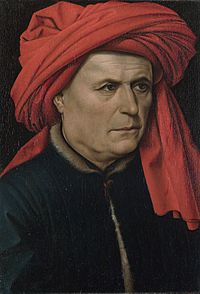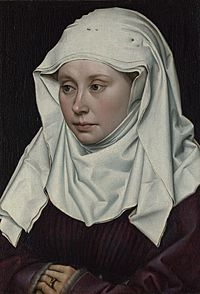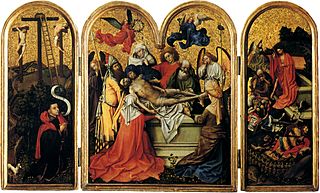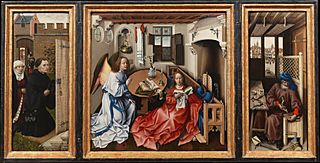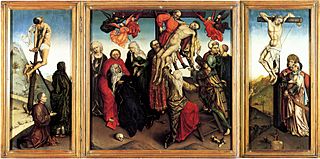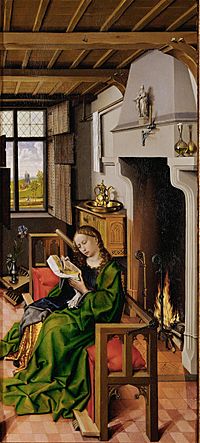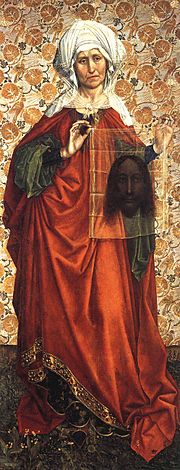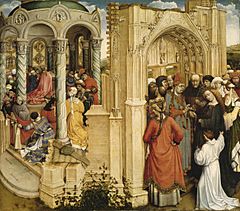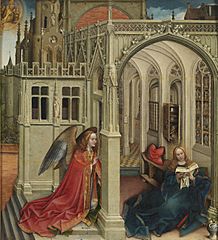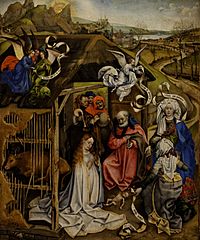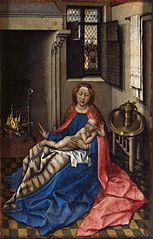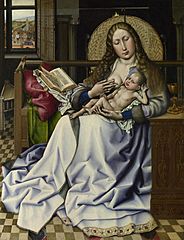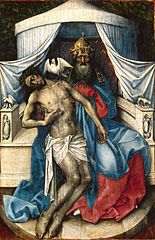Robert Campin facts for kids
Robert Campin (born around 1375, died April 26, 1444) was a very important painter. He is often called the Master of Flémalle. He was one of the first great artists of Early Netherlandish painting. This style of art started in the Netherlands (which is now Belgium and the Netherlands).
Even though Robert Campin was a famous painter, we don't have many of his works signed by him. For a long time, some paintings were thought to be by an unknown artist called the "Master of Flémalle." Now, most experts believe that Robert Campin and the Master of Flémalle are the same person.
Campin was working as a master painter in Tournai, a city in what is now Belgium, by 1406. He became the most important painter there for 30 years. He was a citizen by 1410. He had a large and busy art workshop. He taught famous painters like Rogier van der Weyden and Jacques Daret. Campin also met another great artist, Jan van Eyck, in 1427.
His early paintings show ideas from other artists like the Limbourg brothers. But Campin made his art much more realistic. He did this by using new ways to paint with oil paints. His most famous work is the Mérode Altarpiece, painted around 1425–1428.
Life of a Master Painter
Robert Campin first appeared in records in Tournai in 1405–1406. He was a master in the guild for goldsmiths and painters. We don't know exactly where he was born, but some think it was in Valenciennes.
In 1408, he bought a house near the Tournai Cathedral. By 1410, he became a full citizen of Tournai. Records show he received many requests for paintings. These came from individuals, art groups, and even city leaders. Campin was a successful artist. He owned several houses and invested his money.
Between 1423 and 1429, the city government was run by the guilds. Campin was a leader in the painters' guild during this time. In 1427, he was part of the city council. After the old government returned to power, Campin faced some legal trouble. He was ordered to go on a pilgrimage and pay a fine.
Campin was married to Ysabel de Stocquain. They did not have children. A powerful duchess, Margaret of Burgundy, helped him. This reduced his punishment to just a fine.
Soon after this, his students Rogier van der Weyden and Jacques Daret became master painters. Campin continued to work. His Werl Altarpiece from 1438 shows this. He died in Tournai in 1444.
His Unique Art Style
Campin's art was influenced by old manuscript paintings. But he showed a much stronger sense of realism than any artist before him. He was one of the first to try using oil-based paints. Before this, artists used egg-based paints called tempera. Oil paints helped him create brighter colors.
Campin used this new technique to make his characters look strong and real. He used light and shadow to add depth to his paintings. His works often had complex perspectives. Art experts still discuss if his paintings also contain hidden meanings, like those found in Jan van Eyck's art.
For a long time, people thought Jan van Eyck was the first to use new art ideas in panel painting. But by the late 1800s, it became clear that Campin was painting at the same time. He created works like the Mérode Altarpiece. This altarpiece, painted around 1428, shows amazing attention to detail and realism.
Three other paintings, thought to be from an abbey in Flémalle, are now in Frankfurt. People called the artist of these works the "Master of Flémalle." In the 1900s, many experts suggested that the Master of Flémalle was Robert Campin. This idea came from records showing two students, Jacques Daret and Rogelet de la Pasture (likely Rogier van der Weyden), joined his workshop in 1427.
Paintings by Daret and early works by Rogier look very similar to the Master of Flémalle's art. This makes it seem likely that Daret and Rogier learned from Robert Campin. Some even think that Rogier painted the Flémalle panels when he was young.
Famous Works
The Entombment Triptych (also called the "Seilern Triptych") was painted around 1425. The middle part of this painting shows how Campin was influenced by sculptures. He was known for painting statues. After this, he painted The Marriage of the Virgin and Nativity around 1420–1425.
Around 1425-1428, Campin painted the Mérode Altarpiece. This is a triptych, which means it has three painted panels. It was made for private use. The middle panel shows the Annunciation. This is where the Archangel Gabriel tells Mary she will have a baby. Mary is shown reading in a typical Flemish home.
You can see some of Robert Campin's works in the Hermitage Museum. These include paintings of The Holy Trinity and The Virgin and Child. Other works are in the Prado Museum and the National Gallery in London. Campin also worked with other artists. For example, he helped Jean Delemer paint two wooden sculptures for a church.
Selected works
-
The Marriage of Mary, around 1420
See also
 In Spanish: Robert Campin para niños
In Spanish: Robert Campin para niños


